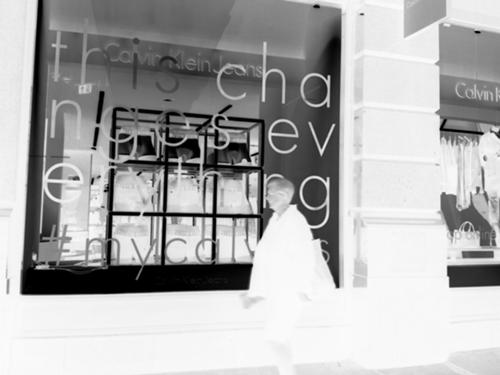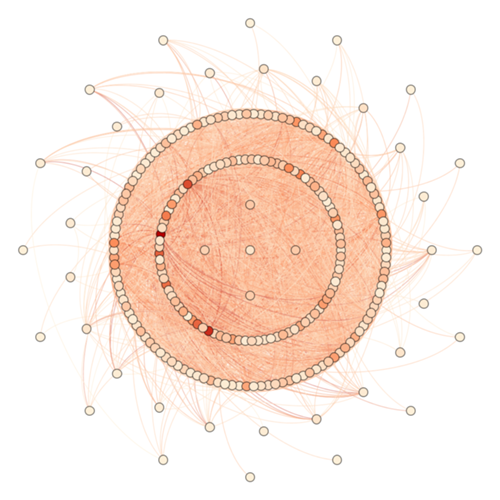Interactivos?'14: Rethinking collective behavior and action. Selected projects

> Riverrun 3
> Darwinian Spaces
> Semiotic energies in the urban space
> HELIUM
> Streetremix
> Puerta d'Mar
> You Are A Virus!
> Collective behaviour and action in communities of data activists
> Biofeedback Cinema
Riverrun 3
by Kevin McCourt, Bartolo Luque, Guillermo Casado

Riverrun studies the way others can influence us when we are creating collectively. We would like to conform a group of creators who collaborate online and in real time in the creation of collective texts. Each creator will participate from his own computer (client), developing a small portion of the collective work.
While the collective text of each experiment is being developed, its crystalization will be shown in a physical space. On the other hand, the data gathered during each experiment will be subject to a scientific analysis afterwards. The experiments and the visualization of all of them will allow us to explore the relationships between scientific techniques in order to understand collective human behavior, as well as other relevant theoretical and artistic concepts.
Will the outcome be a circular narration, without a beggining or an end? Or will certain writers impose themselves as the start or the ending of the story?
Connect with this project through the Community
Darwinian Spaces
by Wendy Ann Mansilla
The interactor enters the installation space and wears the EEG device. The presence of the interactor lights up the wired LED screens. The LED screens are visually representing the major sentiment activation points of the human brain. The screens then start to display momentary representation of dreams and texts taken from the social media. The EEG device activates various sounds depending on the brain electrical activity of the interactor. It also affects the dream representation being displayed - if the interactor is anxious, the machine will give him collective dream types with a negative sentiment as displayed on the screens, and if he relaxes, this will lead to calm dreams and sounds. The result is constant rewiring of the interrelationship between the individual`s inner consciousness and the collective consciousness. As all humans and artifacts get more and more closely connected through the Internet, it's becoming more obvious to think that everything on earth is rewiring into some kind of a global brain. Why don`t we let ourselves be aware of what is happening to us? And that has brought me to propose this installation - our evolving connectedness, the Darwinian Spaces.
Connect with this project through the Community
Semiotic energies in the urban space
by Alejandra Pérez Núñez
In this proyect, which is thought of to be developed collaboratively, we want to study some areas of Madrid like Callao or Sol, all of them areas that are highly congested by passer-bys and exterior advertising. In these areas we will carry out a semantic analysis of the words that are contained in them. Collective work is necessary for the task of gathering all this data on the field, either through photographs or notes. Through the accumulation of words we will look at those that appear more and less often, in relation to others. Through this matrix of words, we will look for semiotic intensity, a presence of the words. In other words, a manifestation of a potential in the linguistic field. Through this project, our aim is to have a deep knowledge of these places, and detect the semiotic concentrations that populate urban spaces.
Connect to this project through the Community
HELIUM
by Félix Ríos
HELIUM is a narrative documentary experience in which the game dictates the ground for group thinking on the political, social and economic problems of our cities, genrerating collective stories that reflect on our surroundings.
It is an immersive role-playing game which registers the decissions taken by each group of players, generating an archive of management narratives in each of its sessions, as well as producing alternative timelines in a common fiction universe, with deep similarities with our own realitites.
Inspired by the Theatre of the Opressed of Augusto Boal, role-playing games and mockumentaries, HELIUM aims at invigorating creative argumentation processes about our cities, regitering the cultural differences between the different groups, cities and countries, as well as experimenting with the Internet as a docummentary media.
HELIUM needs to keep inproving, even mutating to other narratives and contexts. It is an open code project.
Connect with this project through the Community
Streetremix
by Massimiliano Casu
Streetremix is a project which studiesthe intersection between human activity and sound in public spaces, from two basic startpoints: music as a tool of interaction with the human ecosystem, and sound art as an instrument for data gathering and lingua franca for its "visualization". It proposed the development of a collective music production experiment in public spaces through which we can observe the processes of use and occupation of streets, developing an active role as an observer-agitator.
Music and sound in the public space define nowadays one of the more intense spaces of conflict in the urban environment. The policization of sound and its classification as noise is a constant dialectic process in our cities, and its development include legal, technical and cultural aspects. What would happen if we "de-semanticize" and "de-culturize" the emission of music on the streets, transforming urban fitment into a musical instrument and making people produce music only by passing by or occupying a space?
Connect with this project through the Community
Puerta d'Mar
by Andrey Krel, Igor Line, Ismael Tito Freire

What is an Ecosystem? How to make artificial one? What kind of generic ecosystems might be developed? How it can reflect the general processes of evolution through competition and cooperation? How it could be used in real life or lab research?
As a base for discussion we offer - an abstract marine/space ecosystem - Puerta d’Mar. It’s a final project for Master en Artes Digitales @ Universitat Pompeu Fabra, Barcelona lead by Andrey Krel. The work has started as a 2D ecosystem by Imael Tito Freire, Andrey Krel, Clara Lipkau and Alaa Attas. http://infoaliveproject.wordpress.com/
Now Krel continuing development toward a 3D ecosystem in a surround video projection room with a robotic sculpture in the middle – an avatar of ecosystem in real world and control system adopted from Machine to be Another. http://www.themachinetobeanother.org/
The aim of current research is to build this avatar in the context of ecosystem and conduct series of interaction tests between system and user, while the strategic goal beyond university project is to build generic ecosystem.
Connect with this project through the Community
You Are A Virus!
by Simon Whitehouse
What if your social media profile was a virus? We are used to the idea of viral social media content. The use of the word 'virus' as a means to describe how content is distributed on social media platforms is one that is commonly used, albeit without much understanding of how viruses are spread in the real world.
In a different context, contagions and diseases are often referred to as “killer viruses”. This can make for good, sensational copy for news media, but it isn't a very informative description. Mathematical models can be used to predict the spread of a virus through a population.
You Are A Virus! Would like to experiment with taking inputs from numbers available from people's Twitter profiles, such as number of followers, people followed, favourites, Tweets sent etc. and using these in a suitable mathematical model to simulate the spread of a virus. This will, somewhat playfully, start to answer the question!
Connect to this project through the Community
Collective behaviour and action in communities of data activists
by Miren Gutiérrez, Igor Santos, Borja Sanz, Stefania Milan, Javier Nieves Acebo

How do we study a social phenomenon which is rooted in technology and data, an emerging empirical phenomenon for which we need to develop a new vocabulary and methodology? We propose to observe, gather, analyse and visualise information about the activity in social networks and about the interactions and collective actions of a number of communities of data activists in order to understand their behaviour better and draw some conclusions, applying some of the same technologies that ‘data activists’ use to promote social change.
Connect to this project through the Community
Biofeedback Cinema
by Jessica Ann
Biofeedback Cinema is an expanded-cinema-experiment (ECE) that connects an actor's brain to a camera via an open source brain-computer-interface (BCI). The system proposed operates in lieu of a traditional cinematographer. In this case, the actor's brainwaves are dictating the final composition (camera focus, aperture, position, etc).
The project considers new possibilities for the relationship between a variety of otherwise disparate media.
This consideration is made possible via the media itself: artist collaborators, actor, scientist, brainwaves, camera, affect, and audience. As these media converge across the Biofeedback Cinema system, a new platform emerges as a point of communication between art, technology, science, and society.
Connect to this project through the Community

This project has received funding from the European Union’s Seventh Framework Programme for research, technological development and demonstration under grant agreement no 266682



 Medialab-Matadero Madrid
Medialab-Matadero Madrid


